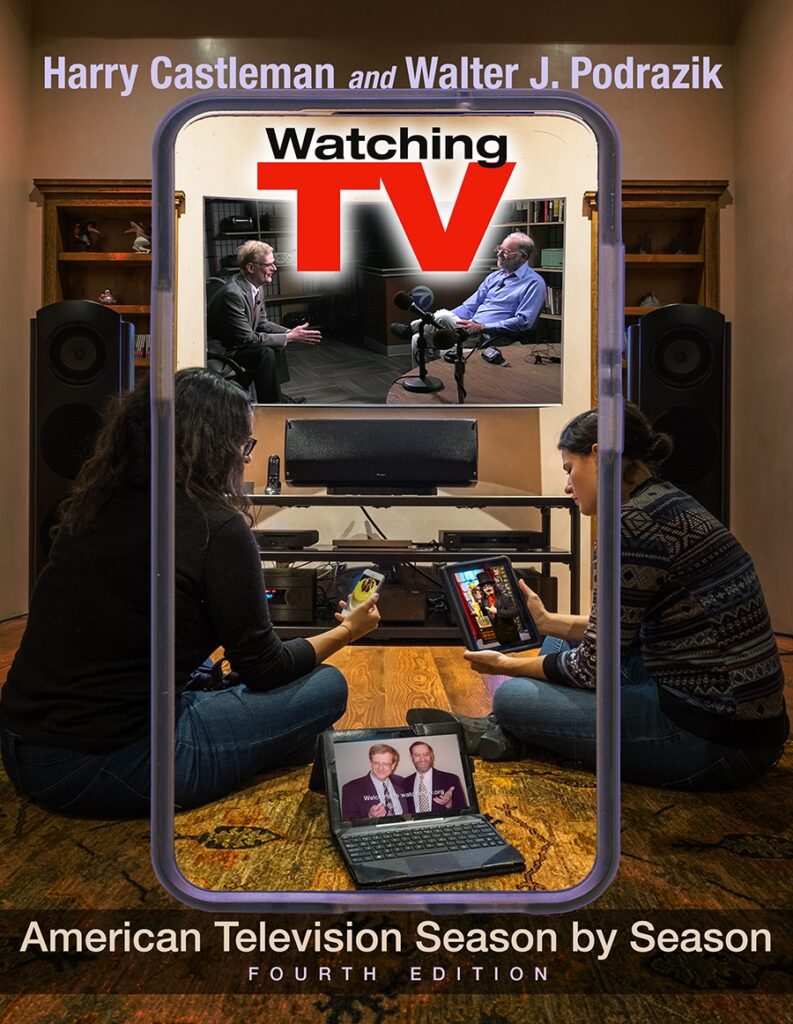By Harry Castleman and Walter J. Podrazik, authors of Watching TV: American Television Season by Season, Fourth Edition
At the January 15, 2024, Emmy Awards telecast, the HBO series Succession emerged as the big winner for its fourth and final season, taking six awards in the drama field for the 2022–2023 season. This time warp delay from the traditional fall/September slot was brought on by a pair of industry strikes in 2023 (writers and actors) and was an appropriate reflection of a larger story for the medium. Change. In Broadcasting. Cable. Streaming. From the on-air content to the corporate business foundations themselves.
Succession had captured viewers with its innovative yet familiar story of high-stakes intra-family power dynamics, modeled on the real-life family empires of Rupert Murdoch and Sumner Redstone. “What comes next?” was the question that hung over them all. Watching TV spells out the context of these machinations in the harsh economic realities where the new video power centers tend to be Netflix, Amazon, and Apple.
Necessary retrenchment was taking place throughout the industry, as the stunning growth of streaming TV and accompanying new video content (dubbed the era of “Peak TV”), with its inflated budgets, had peaked by the start of 2024. The major streaming powerhouses responded by adding or pushing advertising-based subscription tiers, jettisoning “dead weight” catalogue content and cable services, and raising subscription prices. Times had changed.

Emblematic of this industry disruption was the announcement in November 2024 by Comcast of its intentions in 2025 to spin off multiple cable channels from NBCUniversal (such as MSNBC, CNBC, USA, E!, and Syfy) to a separate company. The once automatically lucrative world of cable TV had been overshadowed by its trendier streaming cousin – in buzz if not yet in generated revenue. Meanwhile, some major independent cable services such as Charter fought back against the stampede to streaming, and stared down both the powerful Disney and Paramount Global firms. In 2024, Charter won the right to make available to its premium cable subscribers, at no additional cost, the ad-supported streamers of such media firms.
As described in the fourth edition of Watching TV, the only real guaranteed draw of viewers to the video screen remained live major sports events, which had long served as the lifeblood for cable subscriptions and broadcast television. Yet in 2024 there were disruptions to that status quo as well with streaming continuing to encroach in such areas as the NFL (already on Amazon, and now Peacock and Netflix) and, scheduled for 2025, the move of the NBA from cable’s TNT to NBC, as well as streaming on Peacock and Amazon.
Still, the long-time linear TV model continued to cast its influence on streaming and cable, especially in pursuit of mainstream audiences for scripted series, with familiar styles of storytelling, packaging, and plotting. These ranged from the detective genre of Only Murders in the Building (Hulu) to a remake of James Clavell’s Japanese-based historical epic Shogun (Hulu and cable’s FX network), to the modern-day Western hit Yellowstone, starring Kevin Costner (the Paramount Network cable channel and Peacock streamer).
Most important, though, in 2024 television: the U.S. presidential campaign once again demonstrated the power of the news medium in both coverage and in generating commercial revenue. Even in the contemporary wired world of online influencers and seemingly non-stop video coverage from multiple sources, the familiar elements of traditional TV still proved pivotal, starting with a June debate on CNN between incumbent Joe Biden and Republican former president Donald Trump. In the unforgiving gaze of live television, Biden delivered a disjointed performance that played into Trump’s favor and led to calls for Biden to withdraw from the race.
Soon thereafter, TV cameras caught live an assassination attempt on Trump with a bullet that grazed his ear. As the former president was led off the stage, he gave an iconic, defiant clenched fist gesture that was captured in photos displayed prominently worldwide and at his nominating convention that began two days later. Eight days after the shooting, Biden, still dealing with the ramifications of his poor debate performance, withdrew from the race and threw his support to Vice President Kamala Harris, who was officially nominated at the August Democratic Convention.
For her hyper-speed 107-day campaign, Harris reportedly raised one billion dollars. Prognosticators rated the contest a toss-up, so both candidates pursued every available venue, especially television, flooding the airwaves with commercials (especially in the hard-fought “swing states”). Both appeared on talk shows and podcasts (Harris on ABC’s The View and Alexandra Cooper’s podcast Call Her Daddy, and Trump at a Fox town hall and The Joe Rogan Experience podcast).
Trump and Harris faced off in only one TV debate (in September on ABC), but that did not move the polling numbers much. Subsequently, Kamala Harris trumpeted her celebrity-driven endorsements and glossy media events; reflecting his reality TV instincts, Donald Trump used media to his own advantage by supplementing his paid commercials with “free media” coverage such as heavily photo-op friendly moments including his working a short shift at a McDonald’s fry counter, sitting in the cab of a garbage truck, and dancing-in-place to his favorite music at campaign rallies.
As the 2024 presidential contest wrapped, many anticipated another drawn-out cliff-hanger election night (as in 2020), but Trump out-performed expectations and won reelection by sunrise.
For television executives, a second Trump administration brought different players to the forefront with implications that reflected his priorities on everything from the FCC to the ability to review contemplated business ventures. For viewers, the deliberately disruptive approach of Donald Trump to government promised once again to be delivered daily via television.
Copyright 2025 by Walter J. Podrazik and Harry Castleman. All rights reserved. For use by Syracuse University Press with permission.

